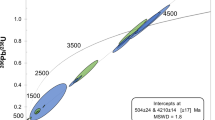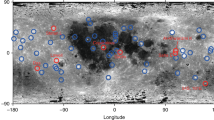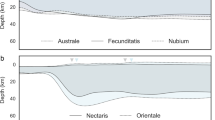Abstract
MANY lunar craters have lava flows associated with them. It is widely accepted that, in most cases, the craters are the result of meteoric impact and not volcanic activity but, if so, the occurrence of lavas needs explaining. It is commonly supposed that the lava flows are material that was melted during the impact process itself but this is not acceptable as a general explanation, for two reasons. First, in several cases the ages of the lavas have been found, by crater counting techniques, to be significantly younger than the craters themselves1 and so they cannot have been formed at the time of impact. Second, some of the lavas show morphology typical of terrestrial lava flows and it is possible to deduce from this that the lava came from sources similar to those of terrestrial volcanoes—that is, lava was supplied at a fairly steady rate over periods of several days and was not simply splash-out from a meteoric impact2. It therefore seems that these lava flows are a product of the presence of an impact crater and yet have occurred as normal volcanic effusions long after the formation of the craters.
This is a preview of subscription content, access via your institution
Access options
Subscribe to this journal
Receive 51 print issues and online access
$199.00 per year
only $3.90 per issue
Buy this article
- Purchase on Springer Link
- Instant access to full article PDF
Prices may be subject to local taxes which are calculated during checkout
Similar content being viewed by others
References
Strom, R. G., and Fielder, G., Comm. Lunar and Planetary Lab., Univ. of Arizona, No. 150 (1970).
Hulme, G., Geophys. Jl R. astr. Soc., 39, 361–383 (1974).
Shaw, H. R., J. Petrol., 10, 510–35 (1968).
Tozer, D. C., The Moon, 5, 90–105 (1972).
Turcotte, D. L., et al., J. Geophys. Res., 77, 6931–39 (1972).
Gash, P. J. S., thesis, Univ. Lancaster (1973).
Pike, R. J., Meteoritic origin and consequent endogenic modification of large lunar craters, U. S. Geol. Survey Open File Report (1968).
Gruntfest, I. J., Trans. Soc. Rheol., 7, 195–207 (1963).
Jeffreys, H., The Earth, Chapter 6 (Cambridge, 1970).
Author information
Authors and Affiliations
Rights and permissions
About this article
Cite this article
HULME, G. Generation of magma at lunar impact crater sites. Nature 252, 556–558 (1974). https://doi.org/10.1038/252556a0
Received:
Issue Date:
DOI: https://doi.org/10.1038/252556a0
This article is cited by
-
Tectonic pattern of the Cr�ger/Rima Sirsalis -Rima de Gasparis region of the moon
The Moon (1977)
-
Interpretation of lunar heat flow data
The Moon (1975)
Comments
By submitting a comment you agree to abide by our Terms and Community Guidelines. If you find something abusive or that does not comply with our terms or guidelines please flag it as inappropriate.



